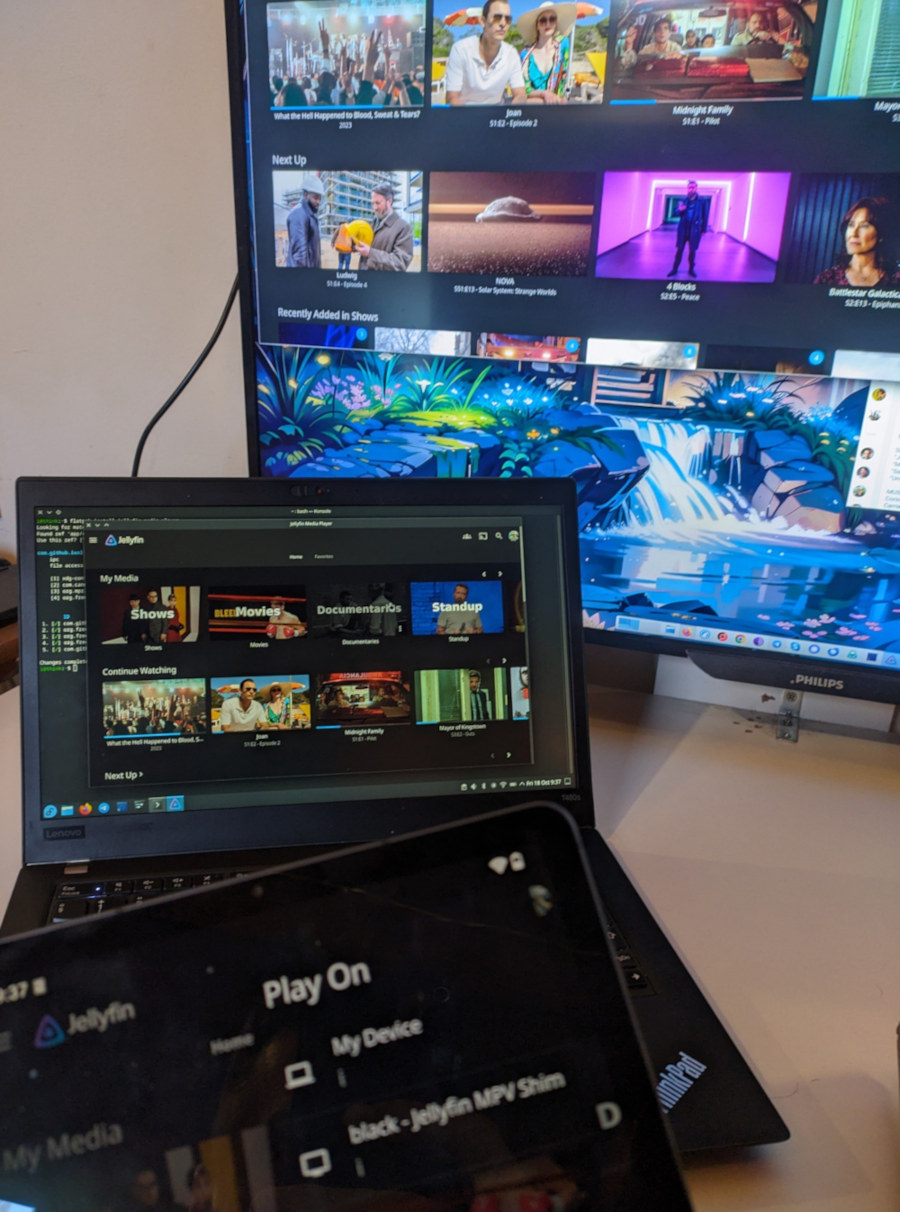

glad it’s working for you but no dice here. installed it fresh on a laptop, same deal, doesn’t detect either of them.

both installs are flatpaks, how about yours?


glad it’s working for you but no dice here. installed it fresh on a laptop, same deal, doesn’t detect either of them.

both installs are flatpaks, how about yours?


this right here. remove partition and apply and then start the installer. there is a way to map this partition in the installer, but that’s such a horrific UX mess that it’s a challenge even for experienced folks.


first off, I have serious doubts that any one dude - or even a group of those for that matter - can ascertain the security of such a complex system; a browser is essentially an operating system, with all the layers and complexities that entails.
even if you’re somewhat successful in such an endeavor, I don’t really care if it potentially is. chromium comes from those shitmakers and I’m not willingly using anything they had their nasty fingers in. they threw one shovel of shit too many on the heap and they are now forever on my ignore list. if that means that I don’t get to access certain domains, sites, and/or apps - so be it, I’ll make do without.


I can’t speak to the doom scenarios (death trap and whathaveyous) but I can share my experience. I was faced with buying what’s considered a new “decent” bike for close to $1K and went the other way - I bought a used one for $80 in sorta OK shape; no idea who made the frame but the majority of its components are of chinese origin.
the rationale was a) to see if I even want the thing - what if I ride it a couple of times and then decide it’s too much bother, and b) I should learn how to maintain it and fix the usual stuff.
three years later, I’ve replaced close to all of the key components by myself - wheels, crank shaft, pedals, front and rear derailleurs, brakes, calipers, cables, chains, tyres, etc. I had no experience fixing anything and got all my education from youtube. some of the gear failed and was replaced, other was upgraded preventively, mostly with shimano’s value line. I’m not blaming the original components for failing, there’s ample wear and tear the way I ride it and I also happen to be kinda oversized for this bike, shoulda gotten an XXL frame.
my advice is, ride the bike as is and replace components as they fail, you’ll learn how to fix stuff in the process and the replacements are super cheap. only then, when you’re a seasoned rider start looking into better alternatives.


fucking edgelords… IA has trouble staying on its feet without this sorta crap.
this has “kicking puppies for palestine” energy - not sure where I’ve read this but it’s an apt analogy.


you can still run both tools, I do so on my main workstation. they stay in the status bar and don’t bother you none. when you’re done working and recline on your sofa, you can send e.g. youtube videos to the rig and they play fullscreen by way of mpv.


I’ve gone the other way - there is no interacting per se with the media PC; instead, it’s a dumb sink that plays back everything you send it, by way of macast and jellyfin-mpv-shim. you use android apps to send it stuff (e.g. newpipe share to allshare which connects to macast and jellyfin android app which connects to JMS) and to control playback (pause, skip, change subs, etc.). so, all media selection and playback control is done from the mobile device, no need to touch the media PC doing the playback.
not sure this will fit into your use case because of spotty internet, but that should prompt you to install jellyfin post-haste. then you have two options, the mentioned android app + JMS or just the jellyfin media player which can run in TV mode with a pared down controller (up/down/left/right/enter/back) - I’ve successfully repurposed an ancient Apple Remote that has just those six keys.


can you run it on multiple devices and have them all synced? how about chat export in a readable format?


hey E., tell Sloane I said “What up”


so I’m gonna pick this as a runner in Lutris, instead of e.g. wine-ge-8-26-x86_64 or whatever? sorry to reply to you, but I’ve read the initial github “explanation” what this does, reread it several times over the months, and now for the final time when it got official and I still don’t understand how this fits into my use case.

Imma take issue with those “reasons”.
#7. the red nubbin
I know what communtiy I’m in but still - it’s the doghittest pointing device. when you add its additional button group IN BETWEEN the keyboard and the touchpad, you’re left with irritants your fingers bump against while trying to actually use the laptop.
they come from a time when it was the only sensible way to navigate a 800x600 GUI. its competition were trackBALLS (remember those fucking things?) and stamp-sized touchpads of the negative precision variety. today, they’re just an irritating anachronism.
#6. repairability
that persists even today. it’s no framework, but I can upgrade and replace almost anything on my T14 and T480s with just standard tools and the replacements are plentiful and cheap. six or seven generation older upgrades aren’t adequately cheaper, it’s often the inverse.
#5. imagine not needing a docking station
the docking station is the greatest thing ever! instead of manually connecting/disconnecting 5+ cables, I connect one cable or i just click the laptop in place and presto - all my shit is connected. if I had to connect my PSU, external monitors, mechanical keyboard, mouse, LAN, sound, etc. one-by-one, I’d go insane. because multiple gens share the same expansions, they are ubiquitous and cheap.
#4. the good, old keyboard
granted, it feels good. the main reason is there’s like a kilo of metal underneath it - no wonder it’s a superb typing experience, moving from that to a consumer grade laptop is verily torture. not so on any reasonably modern thinkpad, the keyboards are better than unibody macbooks, which were the yardstick then.
#3. the upgrades
yeah, you can upgrade your 2nd gen i5 in ridiculous ways - CPU, screen, storage, RAM, cards, etc… but the question is - upgrade it to what? and for how much? by the time you upgrade all those items, you’re still stuck with an ancient device, that’s bulky, heavy, double-digit idle W/hr, etc. as to prices for such activities, don’t even bother.
#1. linux support
is exceptional even on modern devices.
bottom line: when you can have a base modernish thinkpad in the $100ish region that outruns, outbatteries, outdisplays, outconnects even a heavily upgraded device, you’re left with a shitty value proposition. so the only reason you’d be into this is as a hobby, and bear in mind it’s an expensive one. the best analogy I’ve seen is it’s like working on a classic car - the time and expenses and the result are acceptable only to hobbyists.

deleted by creator


good messenger for what?
if you want a solution for you and a bunch of your henchmen to coordinate and discuss totally-not-crimes with ephemeral comms, practically any E2EE solution will work; once the not-crimen is done, burn your accounts and toss the devices for good measure and you’re scot free.
if you want a secure messenger that’s part of a widely used communication platform where you can also do normal people shit and also convert normal people to actually use it (think getting contact deets from cute boy/girl at a bar or giving yours to a business correspondent without an elaborate powerpoint presentation on how to use it) and you want to enjoy the fruits of 20+ years of continuous IM development, like having top-notch UX, battery efficiency, network resiliency, quality voice/video calls, etc., without being spied on then such a thing doesn’t exist.
how come? meredith baxter recently stated that it costs signal $50MM/yr to run their infra. that money has to come from somewhere. if there are no advertising dolts dumping cash on spying on your social graph and convos, the remaining avenues for financing are few and far between.
in closing, there aren’t any super awesome messengers you weren’t aware of, everything is shit.


not to trample on your experiences, but you can make it work. it’s true it’s super cumbersome and involved though.
I’ve had/got it working on a T420s, T480s, T14, MBPr 2012, on debian, fedora, and arch. it helps if it’s not your primary/only workstation so you can tweak it without pressure. keep at it, it’s worth it, I can’t imagine using my laptops any other way.
maybe do I write-up one of these days.


you should enable suspend-then-hibernate instead. laptop suspends normally and if not woken in, say, an hour, the RTC hibernates it to disk.


correct, no idea how I managed to do that.


you’re overcomplicating it. get a separate $20 SSD and install the OS to it, dicking around with wine and tools within virtualbox is a headache you don’t need. set it up as desired (I recommend using flatpak versions of lutris and friends because of freshness) and then install the games one by one, followed by transferring the game data/settings/etc. you can experiment to your heart’s desire because you always have the fallback solution of your original drive.
then, when you know what’s what and where’s what you can make the transition. good luck!


thanks steve! https://lemmy.zip/post/23518695


I mean, OK, it’s a vulnerability and there are interesting implications, but this is hardly significant in any pracitcal sense of the word.
the potential victim has to run their system without a firewall, has to print to the printer they’ve never interacted with before and then the attacker can run shit with whatever the printing system’s user id is, which shouldn’t be an issue on any reasonably modern distro.
I routinely remove cups and friends from any system I run because I have no need for printing and it bothers me to see it constantly during every system upgrade.




found the culprit: I’ve connected my jellyfin-media-player apps to a CNAME alias provided by my Pi-hole (jellyfin.box) and a matching nginx proxy entry:
listen 80; listen [::]:80; server_name jellyfin.box; location / { proxy_pass http://127.0.0.1:8096/; }so when I disconnected the app from the jellyfin.box server and connected it to the “new” server at server.box:8096 it started working immediately. looks like I’m missing some headers in that proxy so I’ll look into it.
edit: yepp, adding headers fixed it, I can connect to the jellyfin.box server and have it detected by all other devices on the network.
location / { proxy_http_version 1.1; proxy_set_header Upgrade $http_upgrade; proxy_set_header Connection $http_connection; proxy_pass http://127.0.0.1:8096/; }